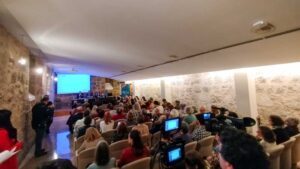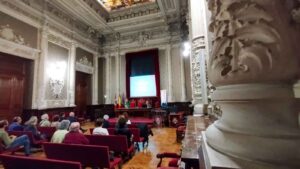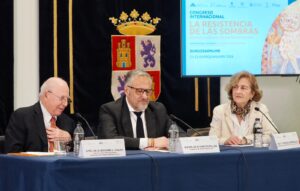ES
Valladolid volvió a demostrar que su patrimonio no solo se conserva entre muros, sino también en la mirada de quienes lo estudian, lo defienden y lo cuentan. La sala de conferencias del Museo Nacional de Escultura, en el Palacio de Villena, se quedó pequeña —dramáticamente pequeña— para la clausura del ciclo Memoria del patrimonio ausente, integrado en el proyecto ‘Nostra et Mundi’, impulsado por la Fundación Castilla y León.
Fue una sesión marcada por la emoción, el interés del público y la presencia de figuras clave del panorama cultural. Tanto, que decenas de personas no pudieron acceder por limitaciones de aforo. A todas ellas, nuestras disculpas más sinceras: en unos días podrán ver la grabación completa en esta misma web.
El broche institucional de la noche lo puso Carlos Pollán, presidente de las Cortes y de la Fundación Castilla y León. En su intervención final definió Nostra et Mundi como “la joya humilde y el buque insignia” de la Fundación para llevar al exterior el valor del patrimonio cultural de nuestra Comunidad. Un reconocimiento claro al trabajo desarrollado este año y al potencial que todavía queda por desplegar.
Más allá de la frase, quedó la sensación de que Nostra et Mundi ha logrado situar en la agenda pública la presencia del patrimonio castellano y leonés en instituciones de todo el mundo, fruto de ventas, traslados, expolios o decisiones históricas de muy distinto signo.
No se puede hablar de la noche sin agradecer la hospitalidad del Museo Nacional de Escultura, institución imprescindible con la que ha sido un privilegio colaborar. Nuestro agradecimiento especial a su director, Alejandro Nuevo Gómez, por su apoyo constante y su implicación desde el primer minuto. Y, por supuesto, a todo el equipo técnico: sabemos que la tarde no estuvo exenta de pequeños sobresaltos tecnológicos. Gracias a todos por la paciencia.
La sesión reunió a tres especialistas de referencia, cuyas intervenciones hilvanaron un relato riguroso, apasionante y en ocasiones sorprendente sobre el destino internacional de algunas de las piezas más valiosas de la ciudad. La profesora de la Universidad de Valladolid María José Martínez Ruiz, coordinadora académica de Nostra et Mundi, abrió la sesión con un estudio que reveló el itinerario, poco conocido por el público general, de dos conjuntos fundamentales del patrimonio de la Catedral: la monumental reja del coro y varios lienzos de El Greco. La intervención permitió desentrañar la historia de la reja del maestro Rafael Amezúa (1763), retirada tras la reforma del coro emprendida en 1923 y finalmente vendida en 1929 al anticuario Arthur Byne, intermediario del magnate William Randolph Hearst. Tras cruzar el Atlántico y dormir durante décadas en los depósitos del Bronx, terminó en el Metropolitan Museum of Art, donde se exhibe desde 1957 como una pieza excepcional de la forja monumental española.
El académico Jesús Urrea repasó el destino de numerosas piezas vinculadas a los conventos históricos de Valladolid, hoy repartidas entre museos y colecciones de distintos países. Su intervención fue un viaje erudito y lleno de matices a través de los avatares de la desamortización, las ventas del siglo XIX y los mercados anticuaristas del XX. Un recordatorio, en suma, de la riqueza extraordinaria que produjo la ciudad… y de cuánto de esa riqueza viajó lejos.
Cerró el acto Manuel Arias, del Museo Nacioal del Prado, una de las voces más autorizadas en escultura hispánica del Renacimiento. Su exposición trazó el periplo internacional de obras de Berruguete y Juni, dos pilares absolutos de la escultura castellana, cuyas piezas se encuentran hoy en ciudades como Londres o Berlín. Un auténtico ejercicio de reconstrucción histórica que permitió comprender mejor la salida de estas obras, su recepción internacional y su lugar actual en los grandes museos europeos.
A lo largo de la jornada quedó claro que Nostra et Mundi no es un proyecto centrado en exigir regresos ni restituciones materiales. Su propósito es otro, más realista y más útil:
reconstruir la memoria de esas obras, contextualizarlas, comprender cómo salieron y recuperar los vínculos culturales con los lugares que las vieron nacer. Documentar sus trayectorias, su significado y su impacto en la identidad de las comunidades que las perdieron es una forma de restitución simbólica y científica que abre espacios de diálogo, investigación y difusión.
Lo vivido anoche en Valladolid deja clara una cosa: hay un interés social enorme por conocer la historia de nuestro patrimonio ausente. La respuesta del público, las intervenciones y el respaldo institucional lo confirman. Gracias a todos los que llenasteis la sala, a quienes os tuvisteis que quedar fuera y a quienes seguís este proyecto desde otros lugares.
Nos vemos en la próxima etapa.



